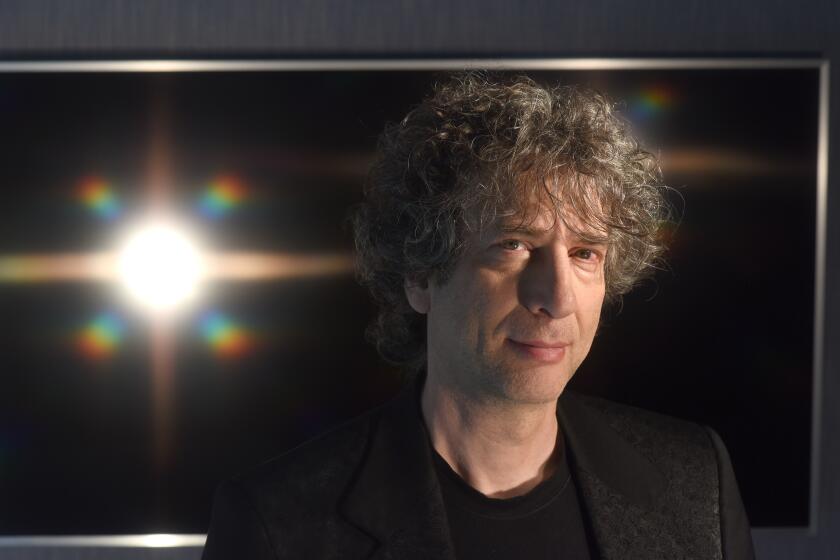10 ways to explore the complicated legacy of Watts through literature
- Share via
The Watts riots, which began 50 years ago, on Aug. 11, 1965, were sparked by a traffic stop. This they share in common with the 1992 Los Angeles riots. Unlike that later disturbance, however, Watts provoked a literary foment as the city struggled — and in many ways continues to struggle — with the uprising and what it meant.
This is not surprising; Watts has a deep literary and cultural history. It goes back at least as far as 1931, when Arna Bontemps published his novel “God Sends Sunday.”
Recalling his upbringing in the first decade of the 20th century, he describes a community in which “the streets … were three or four dusty wagon paths. In the moist grass along the edges cows were staked. Broken carts and useless wagons littered the front yards of the people, carts with turkeys and game chickens and guinea fowl roosting on the spokes of the wheels and wagons from the beds of which small dark mules were eating straw.”
And yet, despite its complicated legacy, as USC professor Victor Jones observes in “(IN)formal L.A.: The Space of Politics,” “many Angelenos never venture to this 2.5-square-mile section of southeast Los Angeles, For most, Watts resides in the collective psyche as euphemism, a one-word cautionary tale of persistent culture, social, and economic tension.”
Here, then, a look at the literary heritage of Watts and what it has to tell us about the city in which we live.
1. The Watts Writers Workshop. In September 1965, a month after the conflagration, novelist and screenwriter Budd Schulberg founded the Watts Writers Workshop, securing the support of the National Endowment for the Arts. The Workshop was an early analog to contemporary institutions such as 826 LA, offering not only writing classes and public programming but also after school programs for students in the community. At its peak, it mentored, or featured, writers including J. Eric Priestley, Quincy Troupe, Kamau Daaood and the Watts Prophets, a performance poetry group that included Richard Dedeaux, Amd Hamilton and Otis O’Solomon. The original Workshop building was burned to the ground in 1973.
2. The Watts Prophets. Growing out of the Watts Writers Project — where its three members met and began to collaborate — the Watts Prophets innovated a jazzy spoken word poetry with an activist sensibility and deep roots in the community. They released albums in 1969 and 1971. The group used performance as a form of confrontation; Dedeaux, who died in 2013, once challenged Muhammad Ali to a poetry duel. “Richard said, ‘Hey man, you are the greatest fighter in the world, I’ll give you that,’” Hamilton recalled in a Times obituary. “‘But you keep saying you are the greatest poet, and that’s not right. We’re the greatest poets,’” The upshot? “With a crowd watching in a hotel lobby, they faced off — Ali did a poem, and the Watts Prophets answered with a medley of poems, punctuated by their improvisational word riffs that music historians now consider a forerunner of hip-hop.”
3. “The Riot Inside Me: A Statistic Speaks” by Wanda Coleman. This essay, which gave title to the author’s 2005 collection, begins as a reflection on the 1992 riots but moves quickly to encompass Coleman’s history, her experience growing up in Watts in the late 1940s and 1950s, and her sense of what the Watts riots meant. “Black had become beautiful,” she writes of the immediate aftermath, referring to the influx of money and community involvement represented by the Watts Writers Workshop among other groups. “From the ashes in Watts sprang a series of arts and educational organization that opened their doors to encourage Black writers and artists.” But, as Coleman recognized even in the moment, it did not, could not last. “The Civil Rights movement was declared over by 1969,” she continues. “Except for programs at the Watts Towers and Inner City Cultural Center, similar programs in Watts … would vanish by 1975.”
4. “A Journey Into the Mind of Watts” by Thomas Pynchon. This essay, originally published in the New York Times Magazine in 1966, offers a stunning slice of life of a community a year after the unrest, a place where debris is a defining feature of the landscape, “both the real and the emotional one: busted glass, busted crockery, nails, tin cans, all kinds of scrap and waste.” It’s a stunning contrast to the falsely rosy view of Watts that Reyner Banham presents in his 1972 documentary “Reyner Banham Loves Los Angeles.” “In the business part of town,” Pynchon writes, as if seeing the future, “… [p]ool halls and bars, warm and dark inside, are crowded; many domino, dice and whist games in progress. Outside, men stand around a beer cooler listening to a ball game on the radio; others lean or hunker against the sides of buildings — low, faded stucco boxes that remind you oddly, of certain streets in Mexico. Women go by, to and from what shopping there is. It is easy to see how crowds, after all, can form quickly in these streets, around the least seed of a disturbance or accident. For the moment, it all only waits in the sun.”
5. “Los Angeles Notebook” by Joan Didion. Unlike Pynchon, Joan Didion did not visit the community to write about Watts; rather, she sought to understand it through a wider lens, that of the city at large and its promise of apocalypse. In this 1967 essay, published in her collection “Slouching Towards Bethlehem,” she assesses the riots by invoking the iconography of the fires, the image of Los Angeles turning inward to devour itself. “The city burning,” Didion writes, “is Los Angeles’s deepest image of itself: Nathanael West perceived that, in ‘The Day of the Locust’; and at the time of the 1965 Watts riots what struck the imagination most indelibly were the fires. For days one could drive the Harbor Freeway and see the city on fire, just as we had always known it would be in the end.”
6. “The New Centurions” by Joseph Wambaugh (1970). When he’d been employed by the LAPD for eight years, Wambaugh began work on this, his first novel. Two years later, as a courtesy, he submitted it for review before its publication — and wound up attracting the department’s ire. The novel, which is fiction, cut a little too close to home: It tracks the lives of three police officers who join the department in 1960 and ends five years later with their involvement in the Watts riots.
7. “The Fire This Time: The Watts Uprising and the 1960s” by Gerald Horne (1995). Horne, who was then a professor at UC Santa Barbara, wrote the first comprehensive treatment of the 1965 uprising. His work is based on hundreds of oral histories — including residents of Watts and the rest of Los Angeles, then-Gov. Pat Brown, not-yet L.A. Mayor Tom Bradley, Martin Luther King Jr., Black Panthers, members of the Nation of Islam, and eventual governor and president Ronald Reagan — that he began gathering before the 1992 conflagration that echoed the events of 1965.
8. “Little Scarlet” by Walter Mosley. Mosley’s 2004 mystery takes place in the immediate aftermath of the disturbance, as his detective hero Easy Rawlins is asked to investigate the murder of an African-American woman named Nola Payne — who may have been killed by a white man at the height of the violence. That’s a terrific set-up, and it allows Mosley to immerse himself in the riots as a watershed event in the history of contemporary Los Angeles — especially the city’s tortured racial legacy. “Fear on one side,” he writes, in the voice of his protagonist, “defeat on the other — I wondered if there would ever be a day where I could see my life as a part of something that didn’t want to reject me or beat me senseless.”
9. “Black Los Angeles: American Dreams and Racial Realities” edited by Darnell Hunt and Ana-Christina Ramon (2010). “The book brings together the research interests of what Hunt describes as an ‘all-star team’ of contributors, most but not all of them academics with strong California connections. Comprising 17 short to medium-length essays, it pivots from data-rich analyses of how the black community’s 20th century demographic center gradually has shifted from Central Avenue to Leimert Park, to interview-driven, anecdotal accounts,” Reed Johnson wrote in our pages. The political, cultural and artistic history of Watts runs through these and other “multidisciplinary, L.A.-centric essays on incarceration’s impact on black families, the relationships between gay African Americans and their religious communities, and the ethnic-minority admissions policies of UCLA, among other thorny topics.”
10. “The Eve of Destruction: How 1965 Transformed America” by James T. Patterson (2012). Patterson, now an emeritus professor at Brown University, observes that “the rage that gripped many of the residents” of Watts “stemmed not only from poverty, overcrowding and racial discrimination but also from the higher expectations that the civil rights movement had helped to excite by 1965.” He sees the events in Watts, alongside the escalation in Vietnam, as the most important of “1965 — the year of military escalation, of Watts, of the splintering of the civil rights movement, and of mounting cultural change and polarization — as the time when America’s social cohesion began to unravel and when the turbulent phenomenon that would be called ‘the Sixties’ broke into view.”
More to Read
Sign up for our Book Club newsletter
Get the latest news, events and more from the Los Angeles Times Book Club, and help us get L.A. reading and talking.
You may occasionally receive promotional content from the Los Angeles Times.







